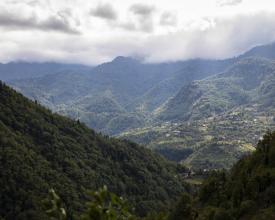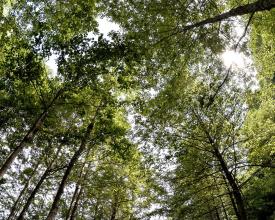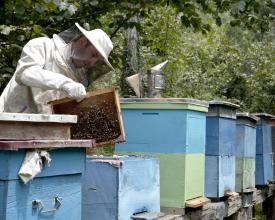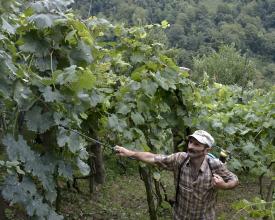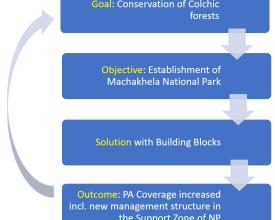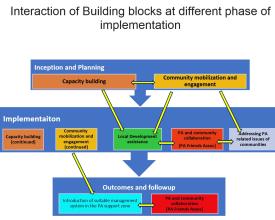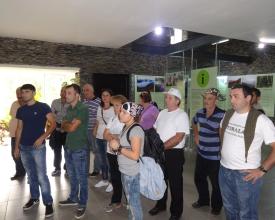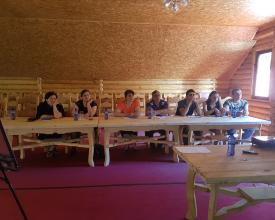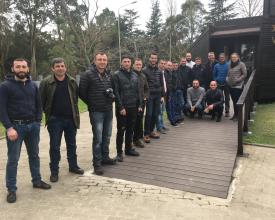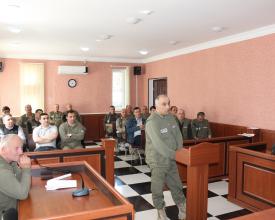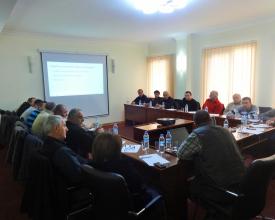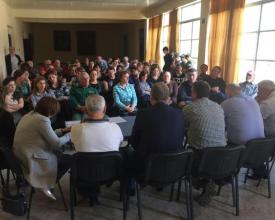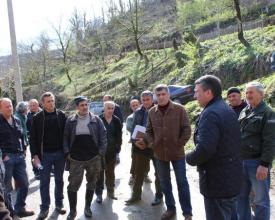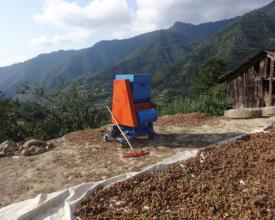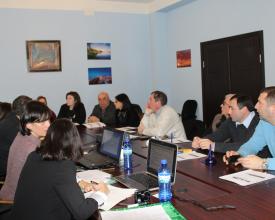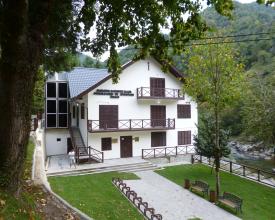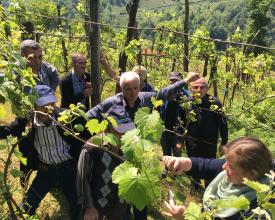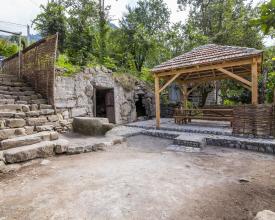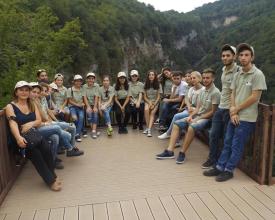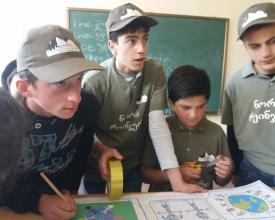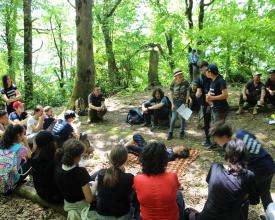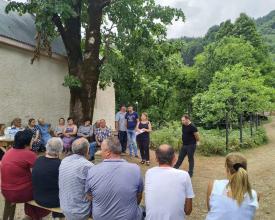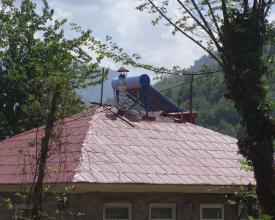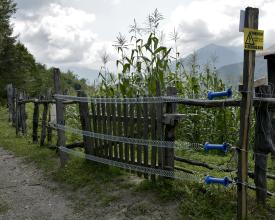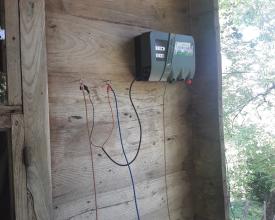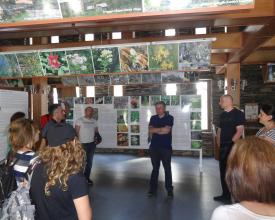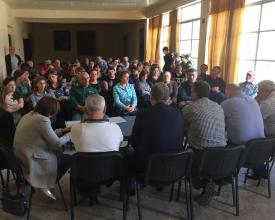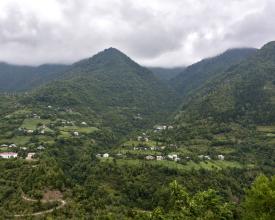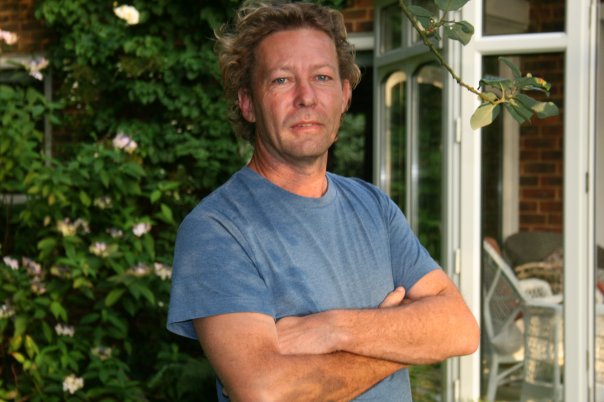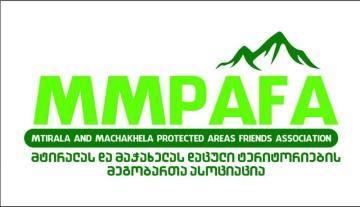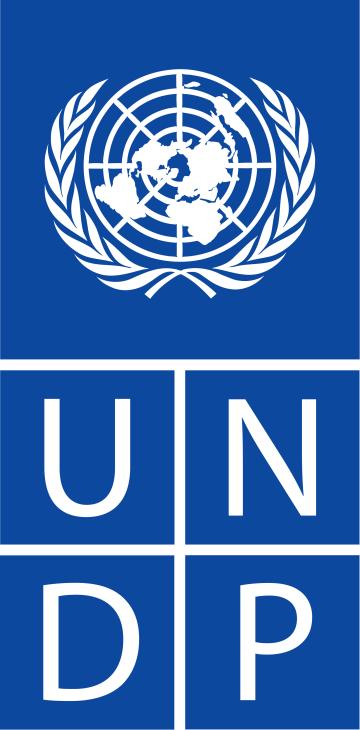
Création de la zone protégée de la forêt de Colchique : de l'opposition au plaidoyer et à l'expansion
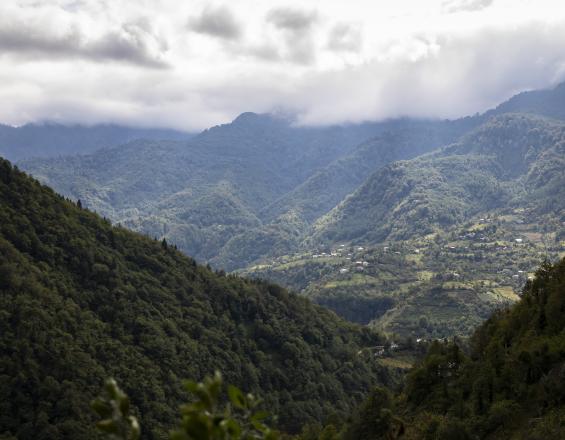
Une partie importante de la région d'Ajara en Géorgie est couverte de forêts de type colchique (forêt pluviale tempérée relictuelle), uniques au monde. Le parc national (PN) Machakhela, qui se trouve entre le PN Mtirala et la frontière turque, a été créé en 2012 pour améliorer la couverture biogéographique et la connectivité de cette forêt en ajoutant un maillon supplémentaire à la chaîne des trois zones protégées (ZP) existantes (Kintrishi et Mtirala en Géorgie et Jamili en Turquie).
Basé sur un ensemble (blocs) d'activités intégrées, le projet "Achara Protected Areas", soutenu par le PNUD et financé par le FEM, a développé une solution qui a aidé à convertir un "parc de papier" en une AP fonctionnelle, et a changé l'attitude de la population locale, qui est passée de la méfiance et de l'opposition à un soutien à la conservation et au développement durable de l'utilisation des terres et des moyens de subsistance dans la vallée de Machakhela.
Contexte
Défis à relever
- Le PN n'avait pas la capacité d'atteindre les objectifs de conservation : pas de limites clairement définies, pas de zonage, pas de personnel formé, pas de bureau, pas d'équipement ni de plan de gestion/opérationnel.
- Opposition des communautés locales à la création du PN et à toute action dans la vallée, perçue comme une restriction de l'utilisation des terres et des moyens de subsistance existants.
- Certaines zones présentant une grande valeur en termes de biodiversité n'ont pas été incluses dans le territoire du PN.
- Structures communautaires peu développées et vision collective limitée du développement futur
- Forte dépendance à l'égard du bois de chauffage, entraînant une pression et des dommages sur la forêt en raison de mauvaises pratiques d'extraction ; risque, temps et dépenses pour les ménages.
- Conflits importants entre l'homme et la faune sauvage causant des dommages et des pertes aux ménages ; manque de données et de moyens permettant d'obtenir un soutien pour résoudre le problème.
- Possibilités de revenus limitées, absence d'infrastructures touristiques, faible nombre de touristes, inexpérience des prestataires de services potentiels en matière de services touristiques appropriés
Emplacement
Traiter
Résumé du processus
- Lerenforcement des capacités qui combine et intègre des formations pertinentes pour une variété de parties prenantes est un moyen efficace d'élargir la compréhension et la sensibilisation de toutes les parties et de construire une large base de capacités et de connaissances locales.
- Lamobilisation des communautés dans les zones de soutien a accru leur capacité à se mobiliser et à coopérer pour atteindre des objectifs sociaux et de développement communs.
- L'aide au développement a permis d'accroître les possibilités et les capacités des communautés à développer et à bénéficier des opportunités touristiques et à améliorer les moyens de subsistance grâce à l'utilisation durable des ressources naturelles.
- Pour soutenir la coopération entre les AP et les communautés locales, une ONG autonome visant à soutenir le développement à long terme et la collaboration entre les AP et les communautés a été créée et fonctionne.
- Letraitement de questions spécifiques liées à la création des aires protégées, telles que la délimitation des frontières avec la participation des communautés locales, l'introduction d'alternatives pour le bois de chauffage et la recherche de solutions aux conflits entre l'homme et la faune, a permis d'accroître la confiance et le soutien envers les aires protégées.
- L'introduction d'un système de gestion approprié dans la zone de soutien garantira que l'ensemble de la biodiversité et du paysage culturel de grande valeur de la vallée soit couvert par un système de gestion viable.
Blocs de construction
Renforcement des capacités de l'administration des zones protégées et des parties prenantes locales
L'objectif du projet était d'accroître l'efficacité à long terme de la conservation et de l'utilisation des terres dans les forêts colchiques de l'Ajara, ce qui nécessitait de renforcer la capacité de toutes les parties prenantes concernées à entreprendre des activités et un développement appropriés à l'avenir.
Pour renforcer ces capacités, le projet a adopté une approche à multiples facettes comprenant
- la fourniture d'équipements et d'infrastructures clés au parc national (PN) et aux ménages locaux
- des formations orientées vers la pratique pour le personnel des zones protégées et les parties prenantes locales - formation formelle/semi-formelle par des formateurs spécialisés ou des contractants
- voyages d'étude en Géorgie
- expérience pratique en cours d'exécution / sur le terrain
Dans ce dernier cas, la stratégie du projet consistait à garantir l'implication des parties prenantes du projet autant que possible dans les activités menées par des contractants et des consultants externes. L'objectif était d'acquérir le plus d'expérience pratique possible au niveau local afin de maximiser les possibilités pour les bénéficiaires d'entreprendre eux-mêmes de telles activités à l'avenir. En d'autres termes, il s'agissait de renforcer l'expérience pratique et la capacité "sur le tas" des bénéficiaires (personnel de l'AP, communautés locales, prestataires de services locaux, etc.)
Facteurs favorables
- L'instauration de la confiance grâce à une meilleure communication : au cours de la mise en œuvre initiale, l'accent a été mis sur l'instauration de la communication et de la confiance entre le parc national et les parties prenantes locales, afin de permettre une coopération significative à l'avenir.
- Une bonne compréhension des problèmes et des priorités des parties prenantes locales : les études entreprises dès le départ ont été essentielles pour identifier les besoins réels de renforcement des capacités du PN et des parties prenantes locales et ont permis d'orienter le soutien au projet.
- Participation et contribution des acteurs locaux.
Leçon apprise
- La combinaison d'une formation formelle et d'une application pratique des compétences sur le lieu de travail (lorsque cela est possible) est beaucoup plus efficace pour renforcer les capacités à long terme. Par exemple, une formation sur l'application de la loi
- Une approche holistique de la formation qui combine et intègre des formations pertinentes pour une variété de parties prenantes dans le contexte d'une AP (c'est-à-dire non seulement le personnel de l'AP mais aussi la communauté locale, les municipalités, les ONG, etc.) est un moyen efficace d'élargir la compréhension et la sensibilisation de toutes les parties, et de construire une large base de capacités et de connaissances locales (par exemple, visite des parties prenantes dans d'autres AP)
- L'existence d'un plan/programme de formation systématique au sein de l'Agence des aires protégées (APA) et la conservation du matériel de formation pertinent et des prestataires de services de formation (c'est-à-dire un mécanisme de centre d'échange de formation) pourraient grandement améliorer l'efficacité future de la formation pertinente pour le personnel des aires protégées.
- La collaboration des efforts de développement des capacités avec d'autres projets de donateurs peut être un moyen efficace de garantir la rentabilité et l'accès à des ressources supplémentaires, ainsi que d'assurer une approche plus coordonnée.
Parc national de Machakhela (MNP) : soutien à la mobilisation et à l'engagement des communautés dans la planification et la gestion des zones protégées
Lorsque le projet a démarré en 2014, il y avait un niveau important d'incompréhension, de méfiance et d'opposition de la part des résidents locaux à l'établissement du PNM et à toute action dans la vallée perçue comme restreignant l'utilisation des terres et les moyens de subsistance existants.
Pour répondre à cette situation, le projet a :
a) initié des actions immédiates telles que les formations du personnel de l'AP et les réunions communautaires organisées dans chaque village, impliquant le personnel du MNP nouvellement formé, afin d'améliorer :
- l'efficacité et la compréhension du personnel nouvellement recruté concernant les objectifs du PN et la manière de communiquer avec les communautés locales et
- la compréhension par les communautés locales de l'impact réel du PN et de ses bénéfices potentiels.
b) Veiller à ce que les activités de délimitation et de démarcation du PNM soient menées en consultant et en impliquant pleinement les communautés locales et à ce que les limites finales soient convenues avec elles.
c) a collaboré activement avec les communautés locales pour renforcer leur capacité à s'organiser et à tirer parti des possibilités offertes par la création du PN.
d) a lancé des activités, avec la participation de l'administration du PNM, pour traiter les questions prioritaires des communautés locales liées aux ressources forestières et à la faune (c'est-à-dire les alternatives au bois de chauffage, les conflits entre l'homme et la faune).
Facteurs favorables
- L'administration du MNP a compris la nécessité d'élargir son champ d'action au-delà des activités "traditionnelles" axées sur la protection et d'encourager une collaboration pratique avec les communautés locales en ce qui concerne leurs priorités (bois de chauffage), les conflits (dégâts causés par la faune) et les moyens de subsistance (tourisme).
- Les études initiales réalisées lors de la création du PNM comprenaient une évaluation des aspects pertinents des situations socio-économiques et des questions relatives à l'utilisation des ressources naturelles, ainsi que des priorités communautaires pertinentes, et ont été intégrées dans la planification de la gestion de l'AP
Leçon apprise
- L'engagement avec les communautés adjacentes aux zones protégées, en particulier pendant le processus d'établissement des aires protégées, peut avoir des avantages significatifs pour la gestion de ces aires protégées en termes de sensibilisation locale et de compréhension de leurs objectifs, de réduction de l'opposition et des conflits, et de recherche d'opportunités de collaboration positives et mutuellement bénéfiques.
- Le processus de création d'aires protégées avec une forte composante de soutien communautaire peut être un catalyseur efficace du développement rural, en aidant à construire des moyens de subsistance plus durables et plus résistants, ainsi que des communautés plus unies.
- Dans les communautés ayant une faible cohésion ou des structures d'auto-organisation existantes, il est important d'initier le soutien par des efforts visant à renforcer le consensus au niveau de la communauté et les capacités d'organisation - cela crée une base efficace pour une participation significative ultérieure.
- Le soutien au développement doit être motivé par les priorités de la communauté et des ménages, à condition qu'elles n'entrent pas en conflit avec les objectifs plus larges de conservation et d'utilisation durable des ressources, et non par des priorités fixées par des "personnes extérieures" (projets de donateurs, agence des aires protégées, etc.)
Développement du tourisme à l'intérieur et à proximité du parc national de Machakhela
Le développement d'un tourisme approprié est un moyen et une opportunité importants pour les zones protégées (ZP) et les communautés situées à proximité d'atteindre leurs objectifs et de répondre à leurs besoins.
Dans le cas des zones protégées, les objectifs sont les suivants
- fournir un service récréatif aux visiteurs
- sensibiliser le public et lui faire comprendre l'importance de la conservation
- générer des revenus qui améliorent la gestion et renforcent le financement durable à cette fin.
Dans le cas des communautés locales, l'objectif est d'augmenter les revenus durables, d'améliorer et de diversifier les moyens de subsistance.
Dans les deux cas, l'accent est mis sur un tourisme "approprié", c'est-à-dire un tourisme qui n'écrase pas ou ne dégrade pas l'attraction touristique fondamentale (c'est-à-dire la nature vierge et le paysage culturel). Dans le cas de l'AP, l'accent est également mis sur les objectifs d'éducation et de sensibilisation. Cela implique que le développement du tourisme soit soigneusement planifié et se concentre sur la maximisation des bénéfices globaux à long terme, plutôt que sur les bénéfices financiers à court terme.
Dans ce contexte, le soutien du projet s'est d'abord concentré sur le développement d'une vision stratégique solide pour le système d'aires protégées de l'Ajara dans son ensemble et pour les aires protégées de la forêt colchique en particulier. Sur cette base, un développement touristique approprié a été soutenu sur le terrain, à la fois dans le nouveau PN Machakhela et de manière générale dans la vallée.
Facteurs favorables
- Existence d'un secteur touristique bien développé sur la côte de la mer Noire et politique généralement "pro-tourisme" des gouvernements d'Ajara et de Géorgie.
- L'élaboration d'une politique de développement touristique à long terme qui tente d'équilibrer les bénéfices avec les objectifs de conservation fondamentaux a aidé à établir un consensus initial et une compréhension des questions et des approches au sein des acteurs du tourisme au niveau de l'Ajara et de l'acteur national des aires protégées - l'Agence des aires protégées.
-
Le recours à des contractants régionaux a permis d'intégrer l'apport et l'expérience des entités touristiques existantes.
Leçon apprise
- Les aires protégées de la forêt colchique ont la possibilité d'augmenter le nombre de visiteurs en se basant uniquement sur leurs valeurs naturelles, sans investir dans des infrastructures importantes - la principale "valeur marketing" des aires protégées est leur valeur intrinsèque en termes de paysages et de nature, et non des "attractions" artificielles qui peuvent être inappropriées.
- Les opérateurs touristiques se concentrent souvent sur la quantité de services et non sur la qualité - pour les destinations écologiquement et culturellement sensibles comme Machakheli, les opérateurs touristiques doivent donner la priorité aux critères de durabilité et se concentrer sur la qualité plutôt que sur la quantité.
- Les consultations individuelles et les formations sur le terrain semblent être la méthode la plus efficace et la plus acceptable pour les locaux en termes de renforcement des capacités.
- La gestion de l'aire protégée devrait établir une communication plus intensive avec la communauté locale et l'impliquer dans le processus de prise de décision pour le développement des produits. Le parc national de Machakhela devrait être présenté par l'agence de l'aire protégée, le gouvernement local et le département du tourisme d'Ajara comme faisant partie intégrante de la vallée. Les stratégies de développement touristique et les plans d'action devraient être communiqués à la communauté locale.
Soutenir la coopération entre les zones protégées et les communautés par l'intermédiaire de l'association des amis des zones protégées (FA).
Au début du projet, ni le parc national de Mtirala ni celui de Machakhela n'étaient soutenus par une ONG locale ou un groupe de soutien. Cependant, une telle organisation pourrait jouer un rôle important dans la promotion des aires protégées, la collaboration entre les communautés locales et les aires protégées, et la prise en compte de leurs priorités de développement.
Sur la base d'une évaluation de l'expérience internationale et nationale, et en particulier de l'expérience existante dans d'autres aires protégées en Géorgie, le projet a soutenu la création et le renforcement des capacités fonctionnelles de l'association des amis des aires protégées de Mtirala et de Machakhela (FA).
Le risque majeur identifié était que de nombreuses organisations de ce type sont fortement soutenues par des donateurs et qu'une fois que ce soutien cesse, elles rencontrent des problèmes pour rester financièrement viables. Par conséquent, le soutien s'est concentré sur le renforcement de la capacité de l'association des amis à être financièrement viable à long terme grâce à une stratégie qui garantit un financement de base à long terme provenant de sources fiables.
L'AF de Mtirala et Machakhela a été créée en 2016 et a entrepris une variété d'activités pour renforcer les relations et la collaboration entre l'AP et les communautés locales, allant des programmes de gardes forestiers juniors et communautaires, à l'organisation de visites écologiques par les écoles, à la promotion du tourisme et à l'application/la mise en œuvre de projets de développement local avec des fonds de donateurs.
Facteurs favorables
- L'expérience nationale existante de la création d'une ONG similaire pour soutenir une zone protégée (le parc national de Tusheti) et une société civile active et relativement bien établie dans le pays.
- L'accent mis dès le départ sur le renforcement de la viabilité financière de l'ONG et l'apport des capacités et de l'expérience existantes dans le pays pour soutenir le processus de création initial.
- L'existence d'un programme national de "camps d'été" et d'une tradition pour les écoles, ce qui permet à l'ONG d'exploiter la demande de services.
Leçon apprise
- Le soutien à la création d'ONG de conservation/développement rural est un mécanisme populaire de mise en œuvre des activités par les projets des donateurs. Cependant, ces ONG sont confrontées à des défis importants en termes de viabilité financière et de maintien de leurs mandats et objectifs initiaux.
- Il existe une demande de services d'éducation et de sensibilisation à l'environnement en Géorgie, en particulier dans le contexte des camps d'été pour les jeunes et d'autres événements similaires visant à renforcer l'expérience des jeunes. Il s'agit d'une source potentielle de financement de base pour les ONG actives dans le domaine des aires protégées, tout en restant fidèles aux objectifs qu'elles se sont fixés.
- L'expérience et les capacités de la Géorgie en matière d'organisation et de gestion durables des ONG/OBC sont limitées, notamment en ce qui concerne la planification financière durable. Il s'agit d'un aspect qui nécessite le soutien et l'attention des donateurs.
- L'approche "Junior Ranger", qui vise à impliquer les communautés locales et à éduquer les générations futures, est une approche populaire, très viable et rentable. L'application de l'approche "Community Ranger" est plus difficile et nécessite des circonstances et une approche appropriées.
Répondre aux préoccupations spécifiques des communautés locales, associées à la création du parc national de Machakhela (PNM)
La création du parc national a eu un impact spécifique sur les communautés vivant dans la vallée, comme la limitation de l'accès au bois de chauffage et l'aggravation des conflits entre l'homme et la faune.
L'approche classique utilisée par le système d'aires protégées pour traiter ces deux scénarios serait basée sur le contrôle et la pénalisation des activités illégales. Cependant, l'approche du projet consistait à essayer de s'attaquer à la cause profonde des problèmes et à réduire ainsi la base du conflit entre le MNP et les communautés locales.
En ce qui concerne le bois de chauffage, le projet a lancé des activités visant à réduire la demande globale en améliorant l'efficacité de l'utilisation et en proposant des alternatives au bois de chauffage. En étroite consultation avec les ménages locaux, le projet a évalué les alternatives potentielles, testé et démontré concrètement les options choisies avec les ménages et, sur cette base, a diffusé les résultats et encouragé la reproduction.
De même, dans le cas des conflits entre l'homme et la faune, l'approche du projet a consisté à tester des méthodes pour atténuer le problème en évaluant la situation et en testant des approches sélectionnées après une évaluation de l'aspect pratique et de la faisabilité.
Dans les deux cas, un aspect essentiel a été l'implication directe de l'administration du PNM afin qu'elle soit perçue comme une partie de la solution aux problèmes des ménages locaux, plutôt que comme une cause.
Facteurs favorables
- la disponibilité d'organisations compétentes ayant des connaissances et une expérience spécifiques pour réaliser des études de faisabilité et l'évaluation des solutions de remplacement
- L'ouverture de l'administration du PNM à s'engager concrètement dans le soutien des initiatives des ménages, comme l'aide apportée aux ménages pour l'achat en gros de coquilles de noisettes utilisées comme alternative au bois de chauffage.
Leçon apprise
- L'introduction de solutions alternatives devrait être promue et priorisée dans les stratégies et plans régionaux et nationaux de foresterie, de zones protégées, de développement rural et d'atténuation/adaptation au changement climatique. Tous les acteurs concernés, en particulier les administrations des AP, les agences forestières, les municipalités, les ONG et les institutions donatrices devraient promouvoir la sensibilisation, la démonstration et la facilitation de l'adoption de solutions appropriées en raison des multiples avantages qu'elles procurent.
- L'implication du secteur privé (détaillants d'équipements appropriés, ateliers et producteurs locaux/nationaux, fournisseurs d'entretien, etc.) sera importante pour s'assurer que les barrières économiques à l'adoption de solutions alternatives sont minimisées.
- L'introduction et la promotion de solutions alternatives doivent être fondées sur une connaissance et une compréhension factuelles des besoins et des possibilités concrètes des ménages ruraux, si l'on veut qu'elles aient une chance d'être adoptées et d'avoir un impact durable. La consultation des communautés cibles et l'évaluation de la faisabilité devraient donc être des conditions préalables essentielles à toute initiative de ce type.
Identifier et introduire un système de gestion approprié pour la conservation de la nature et le développement durable dans la zone de soutien
Sur la base d'une évaluation et d'un inventaire de la biodiversité à l'intérieur et à proximité du parc national de Machakhela (PNM), il a été déterminé que certaines zones précieuses n'avaient pas été incluses dans le territoire du PNM pour diverses raisons pratiques/sociales, en particulier les zones fluviales le long de la rivière Machakhela elle-même.
Le projet a donc mené une enquête spécifique sur les options de gestion de la zone de soutien du parc national de Machakhela, afin d'identifier les options les plus pragmatiques et durables pour améliorer la protection des éléments clés de la biodiversité et des fonctions écologiques en dehors du parc national de Machakhela.
Sur la base d'une analyse et d'une consultation approfondie des parties prenantes, le paysage protégé (PL), catégorie 5 de l'UICN, a été défini comme l'option de gestion la plus pertinente. Le PL proposé assurera la conservation des zones laissées en dehors du MNP et présentant des valeurs écologiques, biologiques, culturelles et panoramiques significatives, ainsi que le développement de l'écotourisme et de pratiques durables d'utilisation des terres.
Le projet a préparé un rapport détaillé d'analyse de la situation et un projet de loi sur l'établissement et la gestion de l'aire protégée de Machakheli et l'a transmis au gouvernement de la République autonome d'Achara. Actuellement, le gouvernement est en train d'initier la loi au Parlement de Géorgie.
Facteurs favorables
- Disponibilité d'informations actualisées basées sur l'évaluation et l'inventaire de la biodiversité dans toute la vallée de Machakheli afin d'identifier toutes les zones importantes pour la conservation.
- Le soutien de la communauté locale et de toutes les principales parties prenantes, assuré par le processus de consultation de la communauté et le soutien de la planification collective, ainsi que la mise en œuvre des priorités locales.
- La volonté, l'engagement et l'enthousiasme de la municipalité locale (Khelvachauri) pour établir et gérer le PL.
Leçon apprise
1. Une communication efficace avec les principales parties prenantes et en particulier avec la population locale à proximité des aires protégées existantes et/ou nouvellement planifiées est essentielle pour leur succès à long terme. Ces contacts et cette communication doivent être maintenus tout au long du processus de création, et en particulier lors de la délimitation des frontières et de la sélection des zones de gestion.
2) Après la création de l'AP, un mécanisme de coordination tel que les "conseils consultatifs", qui comprennent des représentants des communautés locales et d'autres parties prenantes clés, doit être mis en place afin d'assurer une communication continue et la possibilité de résoudre les problèmes et les conflits potentiels.
3. L'expérience du projet démontre que si ces principes sont respectés, un impact significatif sur les perceptions et le soutien aux aires protégées peut être obtenu avec des coûts minimaux et des bénéfices à long terme pour toutes les parties.
Impacts
- Augmentation de la couverture des aires protégées de la forêt pluviale tempérée colchique en Géorgie
- Renforcement des capacités des zones protégées de la forêt colchique d'Ajara et amélioration de l'efficacité de la gestion
- L'ensemble de la biodiversité et du paysage culturel de la vallée de Machakheli est couvert par un système de gestion viable.
- La sensibilisation et la compréhension des communautés locales et des autorités ont été renforcées et celles-ci soutiennent désormais l'existence des zones protégées et s'y engagent.
- Questions relatives au bois de chauffage - les combustibles alternatifs offrent de nouvelles approches pour réduire la dépendance et la consommation de bois de chauffage, qui sont testées et reproduites par les ménages locaux.
- Conflits entre l'homme et la faune : l'ampleur du problème est mieux comprise, des approches nouvelles ou non testées auparavant pour réduire les dommages causés aux biens des ménages locaux par la faune (ours, sangliers, etc.) ont été démontrées et sont en train d'être reproduites.
- Capacité accrue des communautés à se mobiliser et à coopérer pour atteindre des objectifs sociaux et de développement communs
- Possibilité et capacité accrues pour les PN et les communautés locales de développer des opportunités touristiques et d'en bénéficier
- Possibilités accrues pour les communautés locales d'améliorer leurs moyens de subsistance grâce à l'utilisation durable des ressources naturelles.
- Création et fonctionnement d'une organisation non gouvernementale autonome dont le mandat et l'objectif sont de soutenir le développement et la collaboration à long terme des aires protégées et des communautés adjacentes.
Bénéficiaires
- Agence des zones protégées de Géorgie
- Administration du parc national de Machakhela
- Municipalité de Khelvachauri, République autonome d'Adjarie, Géorgie
- Communauté de la zone de soutien du parc national de Machakhela
- Association des amis des zones protégées de Mtirala et Machakhela
Objectifs de développement durable
Histoire
Située dans le sud-ouest de la Géorgie, la vallée de Machakheli se distingue par sa nature, son histoire et ses traditions locales. Au début des années 1990, après l'indépendance de la Géorgie, la récession économique et politique du pays a également eu des conséquences négatives sur la vallée. Après l'effondrement de l'agriculture collective largement subventionnée, les habitants de la région n'avaient pratiquement plus aucun moyen de survivre. La seule ressource abondante était le bois dans les forêts largement intactes. La grave crise énergétique et la forte demande en bois de chauffage ont poussé les habitants à s'engager dans l'extraction illégale et non durable du bois. En raison de sa proximité avec la zone urbaine de Batumi, la forêt de Machakheli et des vallées voisines est devenue la principale source de bois et de chauffage pour les résidents urbains afin de survivre aux conditions hivernales froides et humides, tout en fournissant des revenus aux habitants. D'autre part, l'extraction non durable du bois a endommagé la forêt et sa biodiversité. Après le milieu des années 2000, grâce à l'amélioration de l'approvisionnement en électricité et en gaz et à l'introduction de nouvelles réglementations forestières et de mécanismes d'application, les habitants n'ont plus pu s'engager dans l'extraction du bois. En outre, la plupart des zones forestières de la vallée ont été désignées comme PN afin d'assurer l'expansion et la connectivité des AP existantes établies pour la protection de l'écosystème unique de la forêt de Colchic.
Privés de leur principale source de revenus et craignant que les aires protégées ne limitent l'utilisation des terres et des ressources forestières, les habitants ont commencé à protester. La mise en place de l'administration de l'AP et l'introduction de réglementations ont suscité le mécontentement des habitants, qui ont demandé l'abolition du PN. Lorsque le projet a démarré en 2014, en plus de soutenir l'administration de l'AP nouvellement établie, il devait répondre aux principales préoccupations de la communauté locale.
Les principaux éléments de la solution appliquée sont les suivants
- Renforcement des capacités des AP et des parties prenantes locales
- Mobilisation et engagement de la communauté dans la planification et la gestion de l'AP
- Aide au développement du tourisme
- Soutien à la coopération entre les aires protégées et les communautés par l'intermédiaire d'une ONG locale
- Prise en compte des préoccupations des communautés liées aux aires protégées
- Introduction d'un système de gestion approprié dans la zone de soutien de l'AP
La mise en œuvre de la solution a modifié l'attitude locale : d'opposants au PN, les habitants sont devenus des défenseurs de la conservation de la nature et du développement durable. Ils soutiennent désormais l'expansion de l'AP dans la vallée afin qu'elle puisse couvrir sa principale caractéristique - la rivière Machakhela, ainsi que le reste de la forêt et des habitations.

